This vanilla bean cake bakes up tender, delicious, and studded with beautiful flecks of vanilla bean!
I know some people think vanilla flavored desserts are boring, but this recipe is anything but!
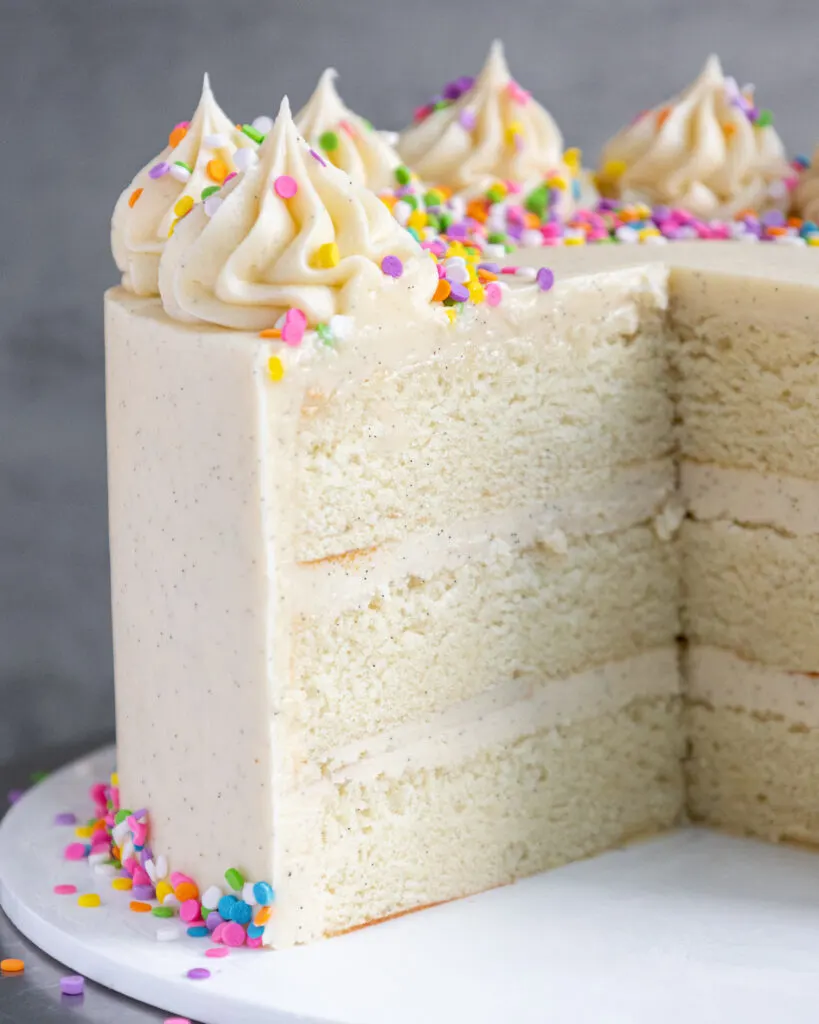
It uses a generous amount of vanilla bean paste in both the cake batter and frosting to give this cake a delicious, warm, vanilla-forward flavor.
How to Make This Vanilla Bean Layer Cake
To make sure this vanilla bean cake turns out as amazing as possible, let’s walk through each step together! I’ve also included a video tutorial of the process below.
I figured it might be helpful to know what tools I use too, so I’ve shared a list below.
Not all of these are mandatory, but they make the process a lot easier.
If you don’t have all these things on hand, feel free to improvise and work with what you have.
- 3, 8-inch cake pans
- Spinning cake stand
- Electric hand mixer or stand mixer
- 10-inch greaseproof cake board
- Large offset spatula
Step 1: Bake the Vanilla Bean Cake Layers
Make the vanilla bean cake layers first following the recipe card at the bottom of this post.
Divide the batter evenly between the prepared cake pans and bake for 33-35 minutes or until a toothpick comes out with a few moist crumbs.
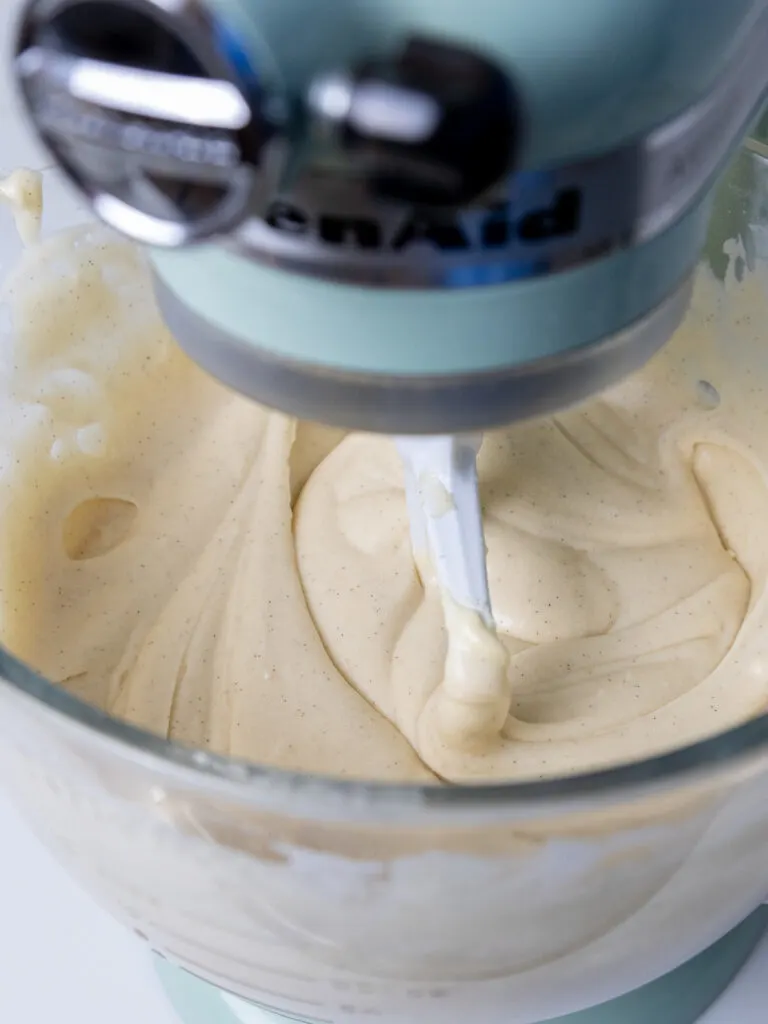
Remove the cake layers from the oven and let them cool in the pans for about 30 minutes.
Gently run an offset spatula around the rim of the cake pans to loosen them, then flip them onto wire racks to finish cooling.
These layers bake up pretty flat, so leveling them is optional! If you want to level them, use a serrated knife to level the top of each cake layer.
I also like to trim away the caramelization around the sides of the layers.
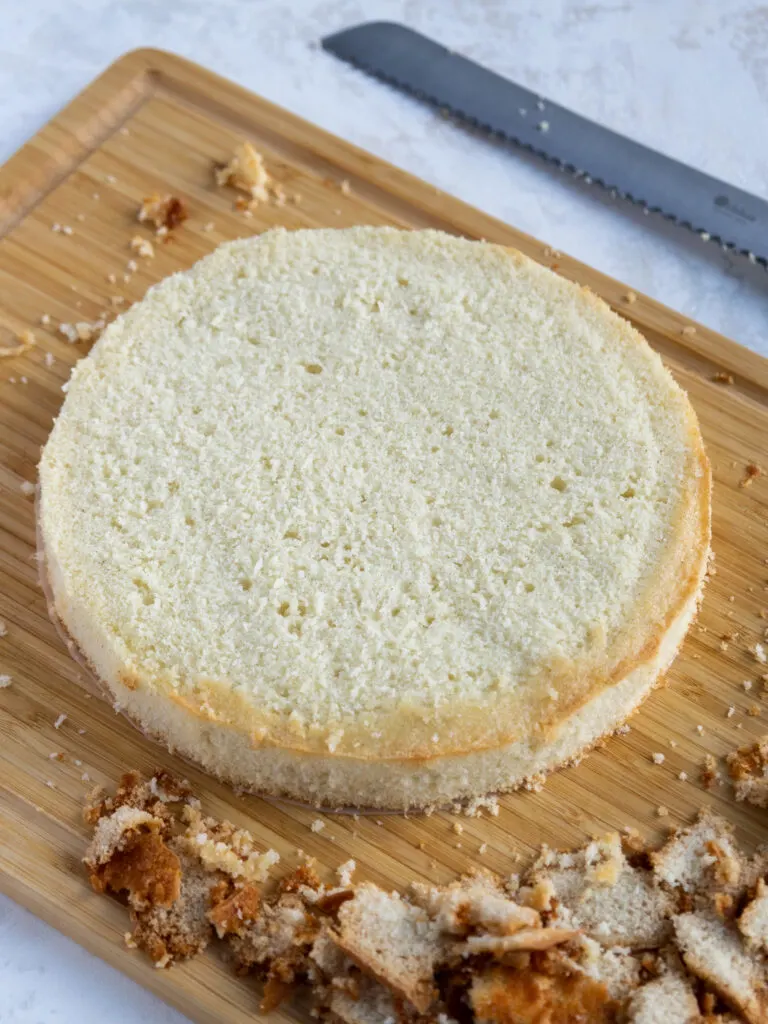
If you’re making these in advance, you can wrap and freeze them at this point.
Step 2: Make the Vanilla Bean Buttercream Frosting
While the cake layers bake and cool, make the vanilla bean buttercream.
I like to use an American buttercream base to make this frosting because I think it’s the easiest to make and I love eating it. However, it is quite sweet!
If you want to use a less sweet frosting base, I’d recommend making a batch of my Swiss meringue buttercream or my hybrid buttercream and adding the same amount of vanilla bean paste that this recipe calls for.
This frosting can also be made in advance if needed and kept in the fridge for up to a month.
Step 3: Stack and Frost the Cake Layers
Then it’s time to assemble this cake! Stack and frost cake layers on a greaseproof cake board or flat plate. Use a dab of buttercream to help stick the first cake layer to the board.
Spread an even layer of vanilla bean buttercream on top of each cake layer with a large offset spatula.
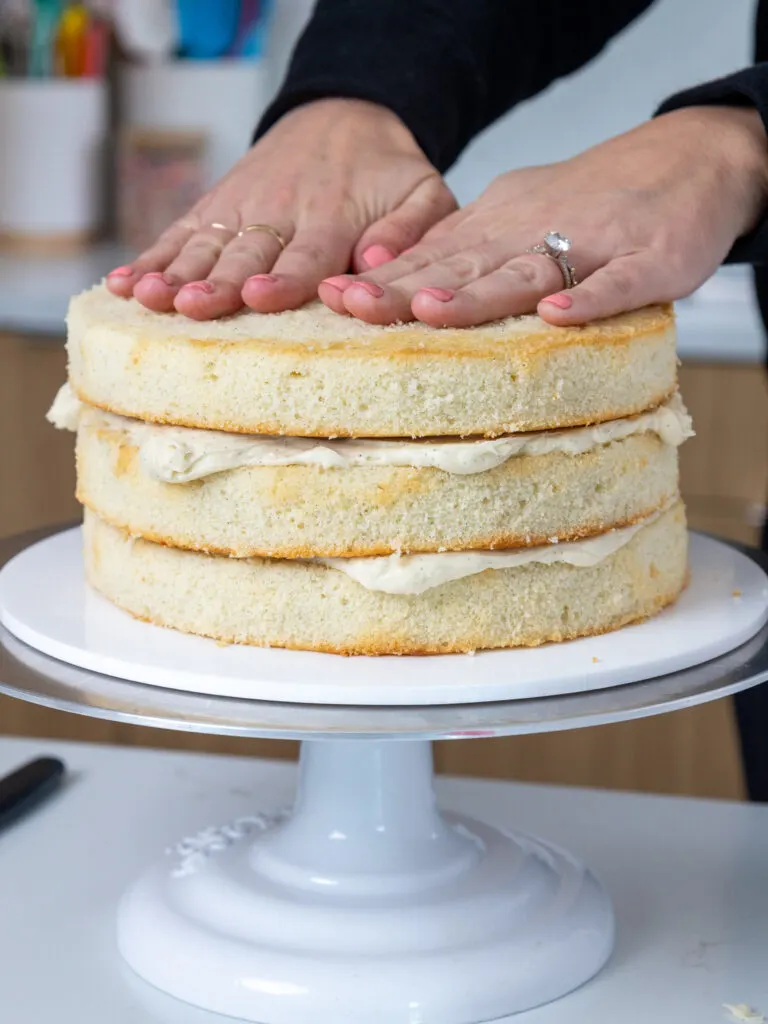
Repeat with the remaining cake layers and place the top cake layer upside down to make the cake easier to frost.
Step 4: Crumb Coat the Cake
Spread a thin coat of frosting around the cake to fully cover the cake layers.
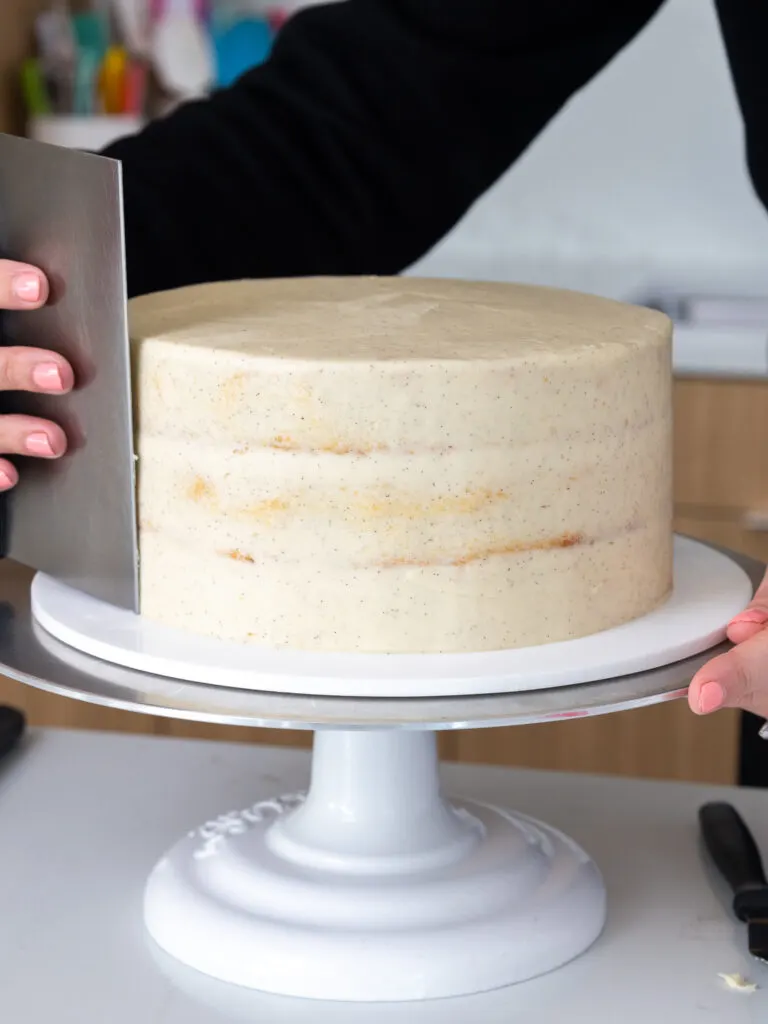
Smooth the frosting using a large offset spatula or bench scraper, then chill the cake in the fridge (30 minutes) or freezer (10 minutes) until the frosting is firm to the touch.
Step 5: Add the Second Layer of Frosting & Decorate
Then add a second, thicker layer of frosting to the cake.
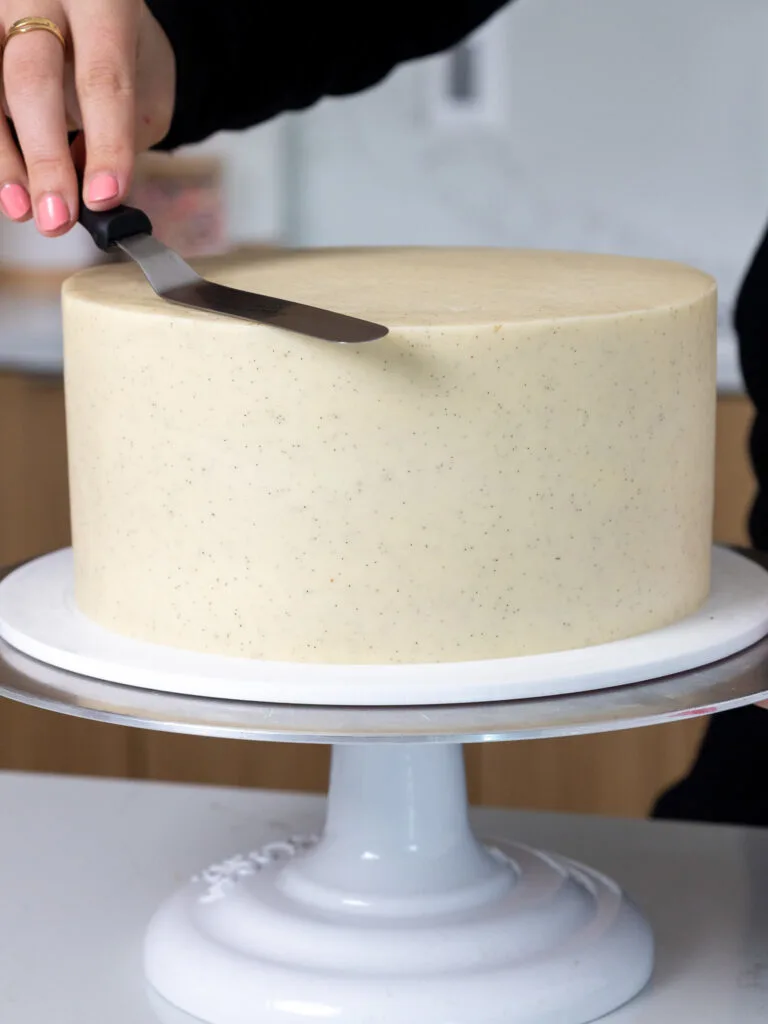
Smooth the frosting using a large offset spatula or bench scraper. Decorate as desired, then enjoy!
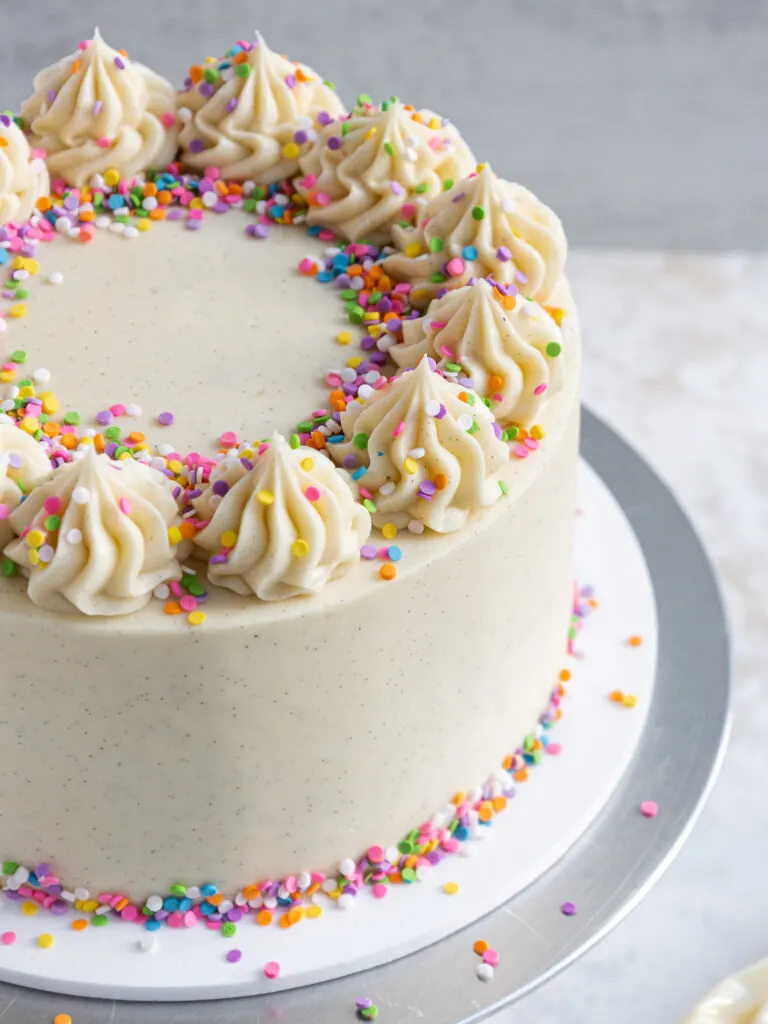
If you’re making this cake in advance, it can sit at room temperature for up to a day or be stored in the fridge for up to a week.
Substitutions and Swaps – Vanilla Bean Layers
This recipe uses quite a few ingredients and I know you might not have them all on hand. Or if you have food allergies or restrictions, I’ve got you covered.
Below are some swaps and substitutions that can be made in this cake recipe.
- All Purpose Flour – This recipe turns out best with AP flour, but you can use a gluten free flour blend or cake flour if that’s all you have on hand.
- Granulated Sugar – I do not recommend changing the type or reducing the amount of sugar because it will change the texture of the cake layers.
- Unsalted Butter – If you only have salted butter on hand, you can use it in place of the unsalted butter in this recipe. Just be sure to omit the salt that this cake recipe calls for. You can also use vegan butter in its place (and also omit the salt)!
- Egg whites – I like to use the pasteurized egg whites that come in a carton, but you can also use fresh egg whites or 4 whole, large eggs. If you have an egg allergy you can use flaxseed eggs or an egg replacer.
- Sour Cream – You can also use full fat yogurt, whole milk, or an alternative yogurt or milk (almond, soy, oat) if you’re dairy free.
- Vegetable Oil – Any flavorless oil will work in this recipe. Canola or even sunflower oil would work great!
- Vanilla Bean Paste – A high-quality vanilla bean paste is an absolute must in this recipe! I love using Heilala or Nielsen-Massey. You can use vanilla extract if you have to, but the flavor and look (no vanilla bean specs) won’t be the same.
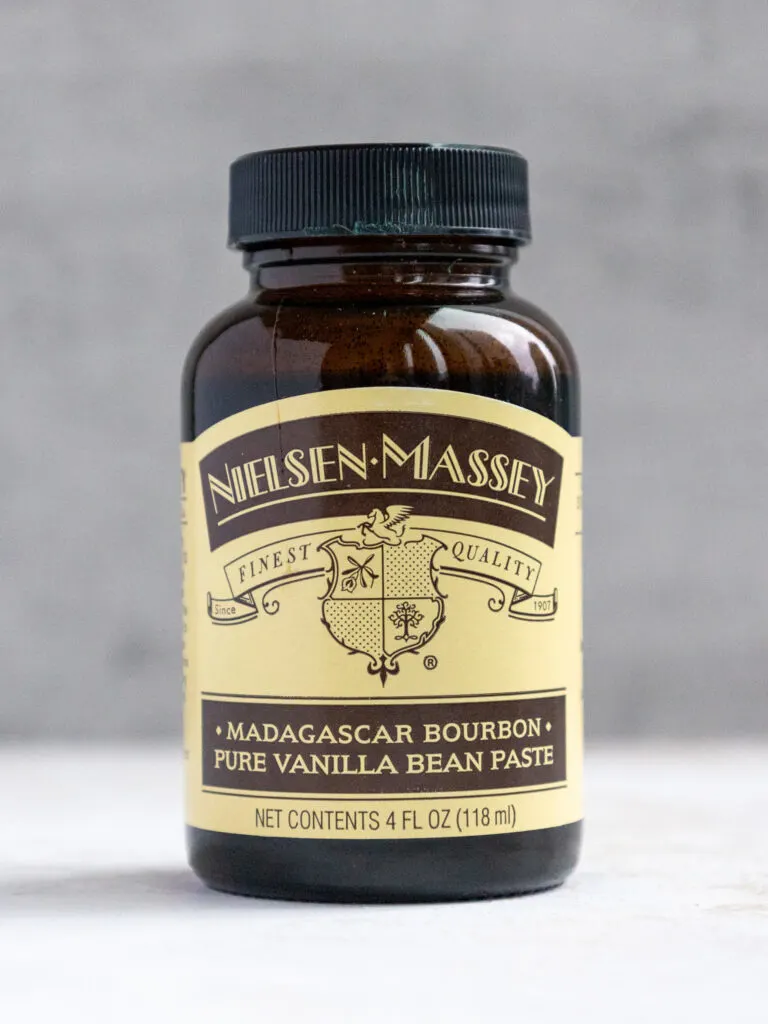
Substitutions and Swaps – Vanilla Bean Buttercream Frosting
- Unsalted Butter – If you only have salted butter on hand, you can use it in place of the unsalted butter. Just be sure to omit the salt that this frosting recipe calls for. You can also use vegan butter in its place (and omit the salt)!
- Heavy Cream – Whole milk or alternative milk (soy, almond, oat) will work fine in this frosting recipe if that’s what you have on hand.
- Vanilla Bean Paste – A high-quality vanilla bean paste is an absolute must in this recipe! You can use vanilla extract if you have to, but the flavor and look (no vanilla bean specs) won’t be the same.
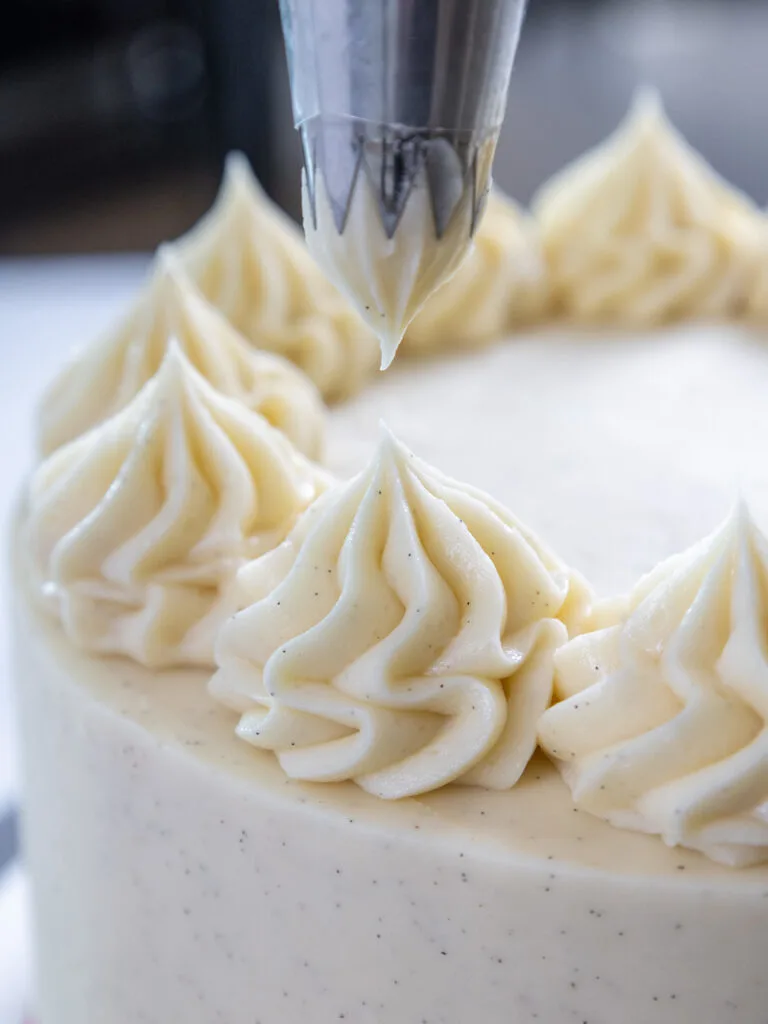
Making This Vanilla Bean Cake in Different Sizes
I used 8″ cake pans to make this cake, but this recipe can be used to make different sized cakes.
You can make four 7- or 6-inch cake layers with one batch of batter. Bake the cake layers at 350 F / 175 C for 34-40 minutes or until a toothpick comes out with a few moist crumbs.
One batch of batter can also be used to make one 9×13-inch sheet cake. Bake it at 350 F / 175 C for 40-50 minutes and use flower nails or heating cores to help the cake bake evenly.
It should end up being about 2 inches tall.
If you want to make cupcakes, I highly recommend using my vanilla cupcake recipe and using vanilla bean paste in place of the vanilla extract in that recipe.
Tips for Making the Best Vanilla Bean Cake
- Ingredients at room temp mix together better! Set out any cold ingredients ahead of time.
- Properly measure your flour (spoon into the cup measure, then level). Or better yet, use a kitchen scale to measure your dry ingredients.
- Use a scale to weigh your cake pans as you fill them. It will make the cake layers bake up to be the same height and bake more evenly.
- Level the room temperature or thawed cake layers with a serrated knife to make them easier to stack.
- Make sure the buttercream is the right consistency. This will help give the cake proper structure and make it easier to decorate.
- Chill the cake layers in the freezer for about 20 minutes before assembling the cake. It makes them so much easier to stack and frost!
- If your cake layers turn out less than perfect, read my cake troubleshooting guide to see where things might’ve gone awry.
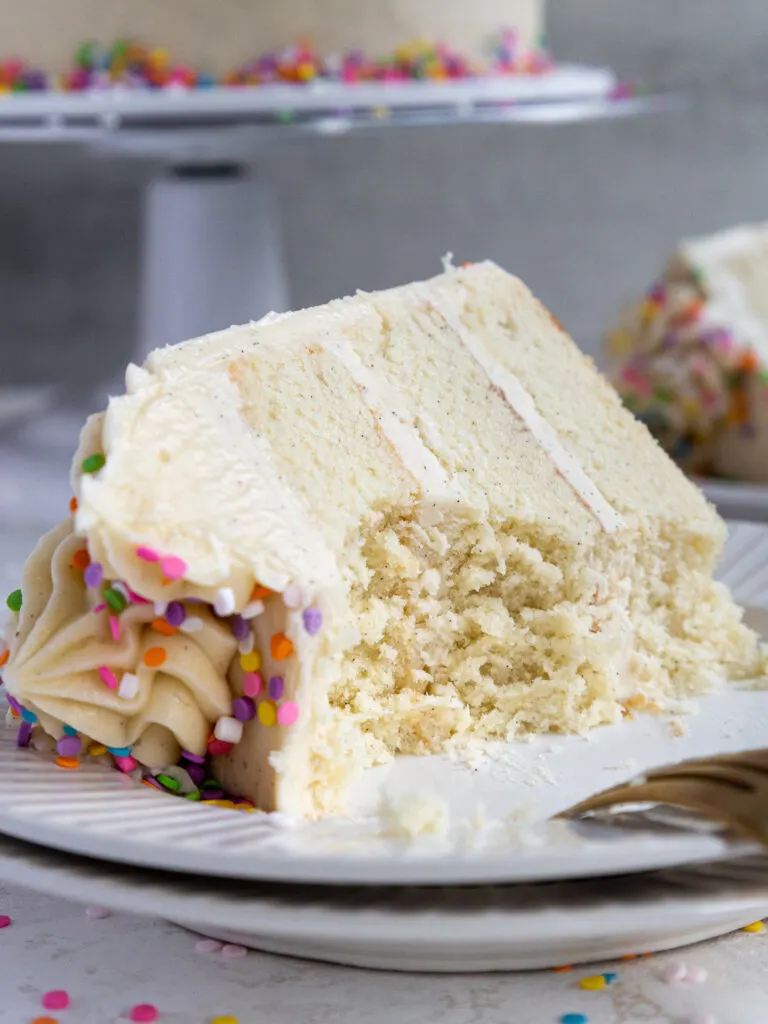
Making This Vanilla Bean Cake in Advance
I highly recommend making these cake layers in advance and freezing them. It breaks the process up and makes it more approachable.
You can also make the frosting ahead of time too or save any leftover frosting! It can be stored in an airtight container in the fridge for up to a month, or in the freezer for up to 3 months.
Be sure to give it a good stir once it thaws to get the consistency nice and smooth again.
A frosted cake can last in the fridge for up to a week, or in the freezer for up to a month. The buttercream locks in all the moisture, keeping the cake fresh and delicious!
If you cut into the cake and have leftovers, use any remaining frosting to cover the cut section to keep it moist and store in the fridge for up to a week.
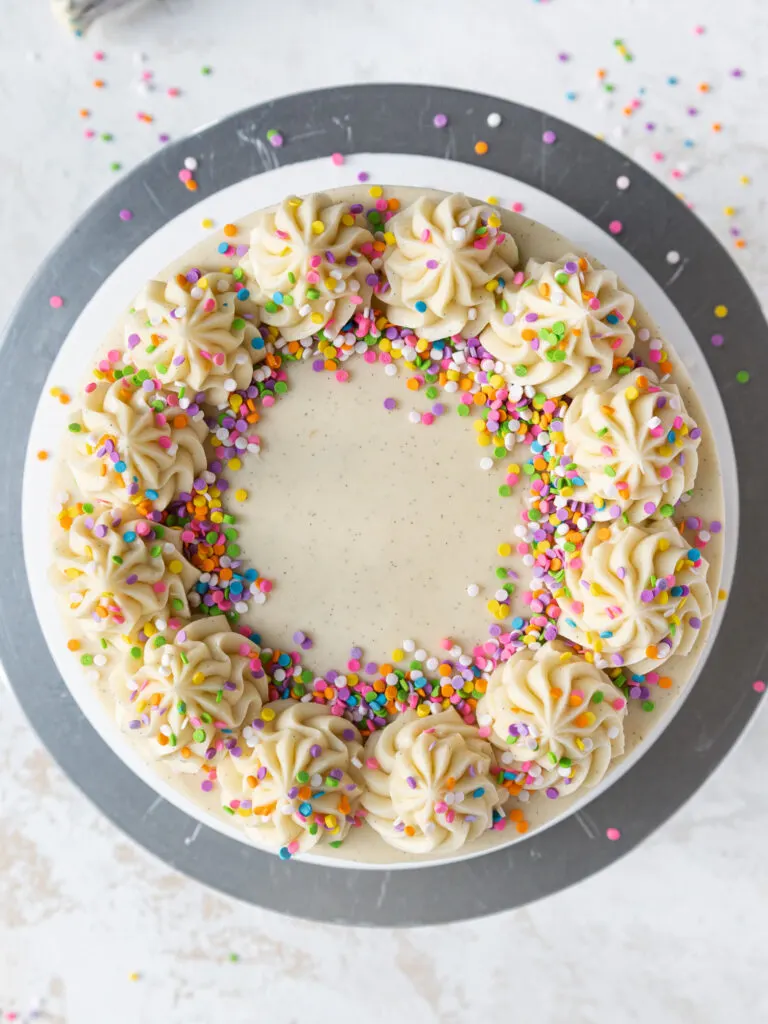
Let Me Know What You Think!
If you make this vanilla bean cake recipe, I’d love to hear what you think of it! Let me know by leaving a rating and comment below.
And don’t forget to tag me @chelsweets and use #chelsweets if you share on social media so that I can see your amazing creations.
Other Recipes You Might Like:
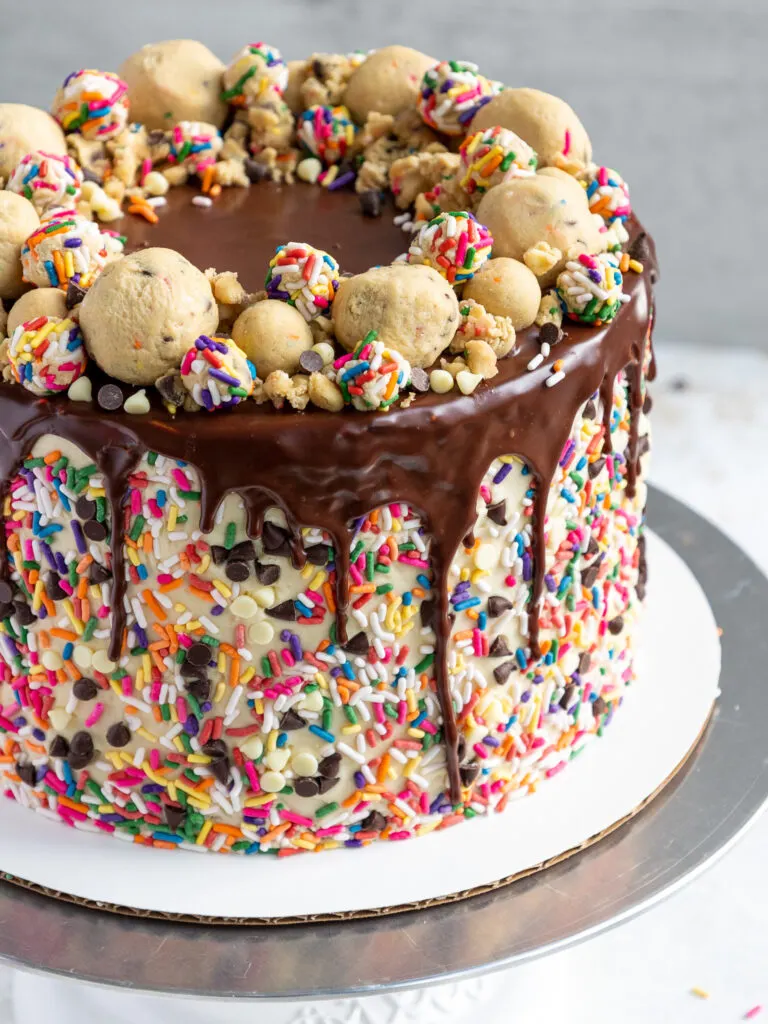
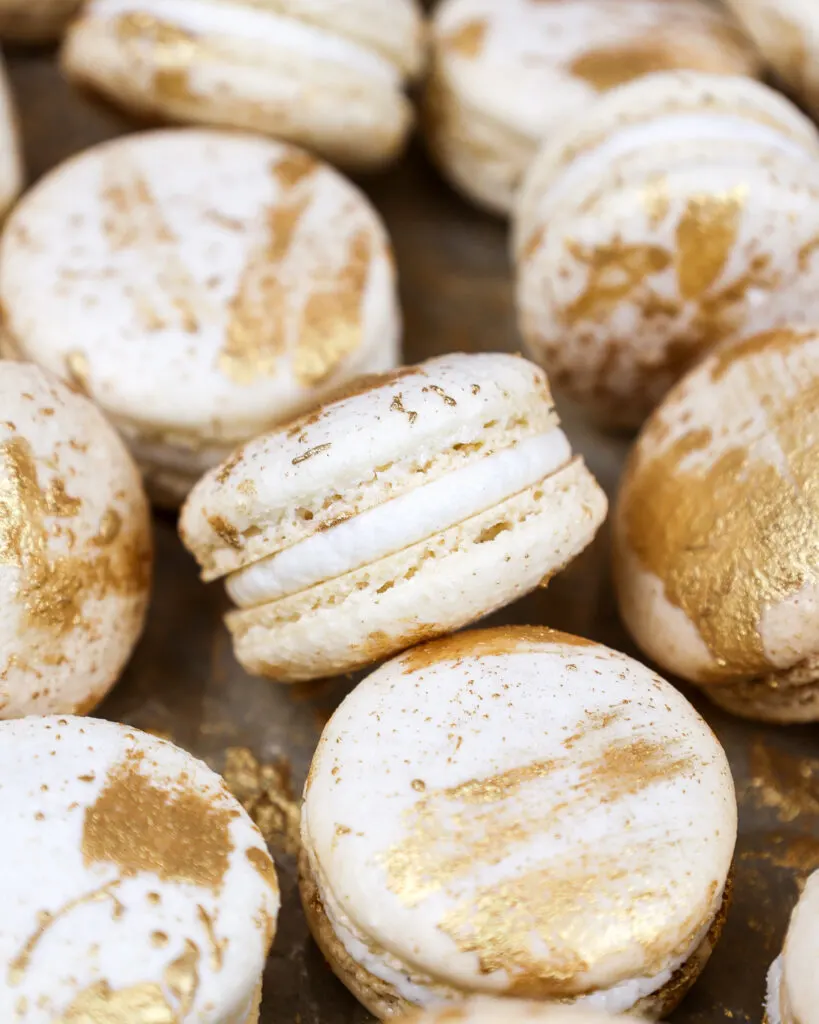
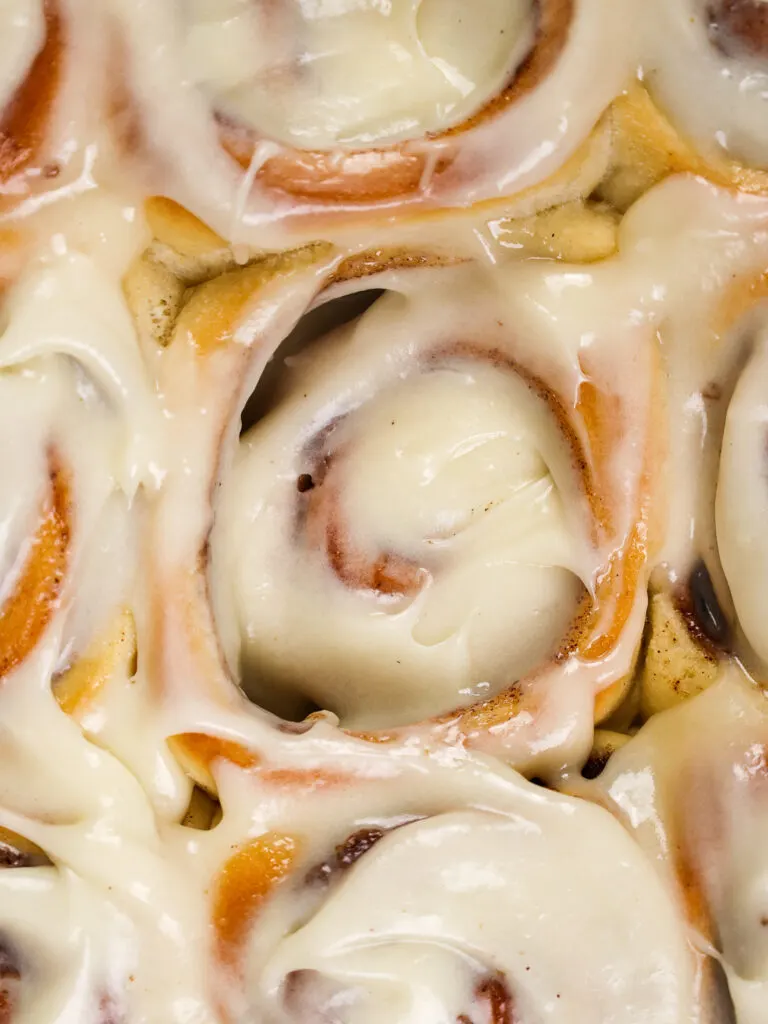
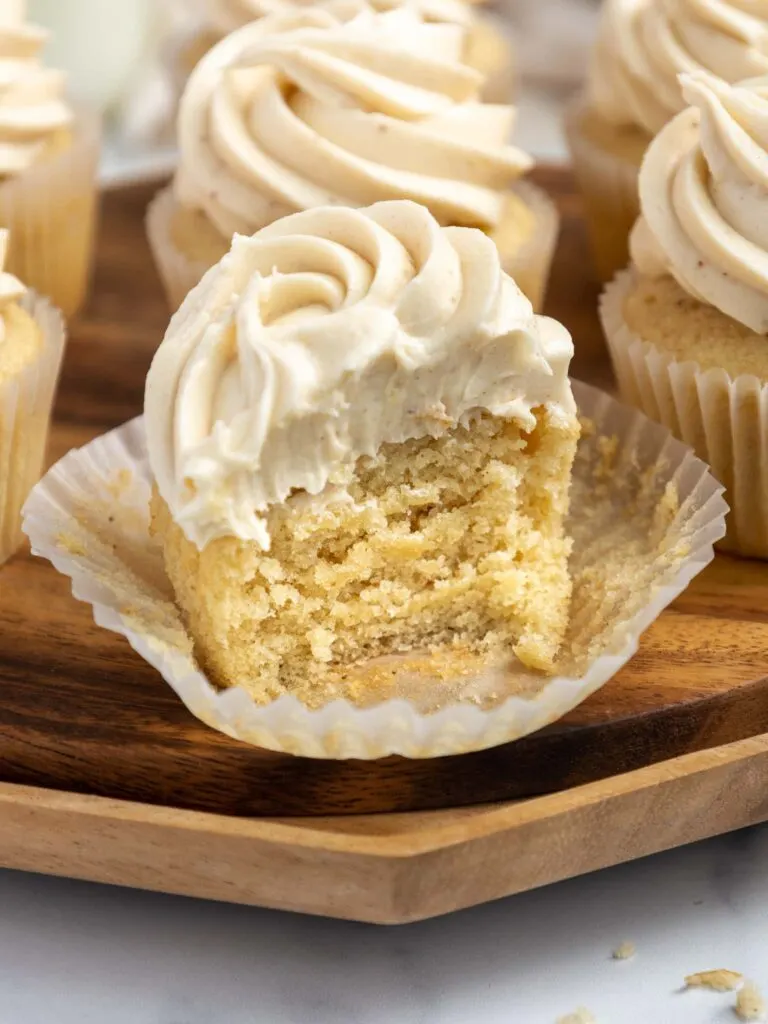
Vanilla Bean Cake
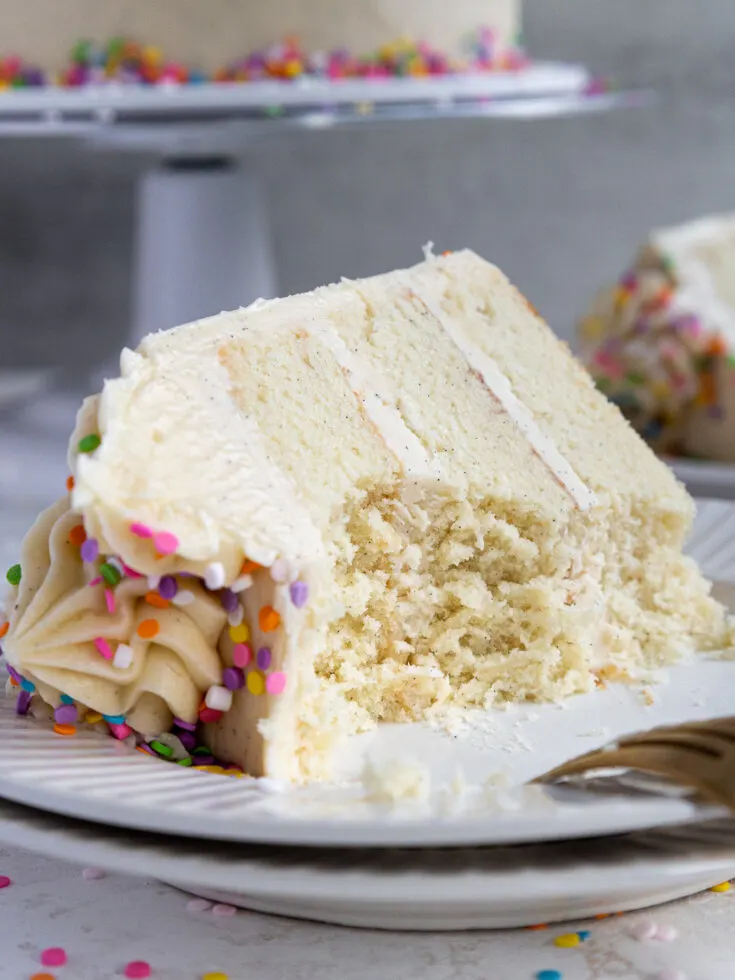
This vanilla bean cake recipe bakes up tender, delicious, and studded with beautiful flecks of vanilla bean!
Ingredients
Vanilla Bean Cake Recipe
- 3 cups all-purpose flour (375g)
- 3 cups granulated sugar (600g)
- 2 1/2 tsp baking powder (10g)
- 1 tsp fine salt (6g)
- 1 cup unsalted butter, room temp (226g)
- 1 cup egg whites from a carton or about 7 egg whites, room temp (235g)
- 1 1/2 cups sour cream, room temp (360g)
- 2 Tbsp vegetable oil (30g)
- 1 Tbsp vanilla bean paste (12g)
Vanilla Bean Buttercream Frosting
- 2 cups unsalted butter, room temp (452g)
- 2 Tbsp vanilla bean paste (24g)
- 1/2 tsp fine salt (3g)
- 7 cups powdered sugar (875g)
- 1/4 cup heavy cream or whipping cream (60g)
Instructions
Vanilla Bean Cake Layers:
- Preheat oven to 350°F / 175°C. Line four 7" or three 8" pans with parchment rounds and grease with non-stick baking spray or homemade cake pan release.
- Mix 3 cups all purpose flour, 3 cups sugar, 2 1/2 tsp baking powder and 1 tsp salt together in a stand mixer with a paddle attachment or hand mixer until fully combined.
- Mix in 1 cup of room temperature, unsalted butter slowly into the dry ingredients on a low speed. Continue to mix until no large chunks of butter remain, and the mixture looks like moist sand.
- Pour in 1 cup of egg whites and mix on low until just incorporated. Scrape the sides and bottom of the bowl as needed with a rubber spatula.
- Then mix in 1 1/2 cups sour cream, 2 Tbsp of vegetable oil, and 1 Tbsp of vanilla bean paste on a low speed until fully incorporated.
- Scrape down the sides of the bowl with a rubber spatula one more time, then beat on a medium speed for about 30 seconds to make sure everything is properly mixed together. This also helps lighten the texture of the cake layers.
- Divide the batter evenly between the prepared pans. I like to use a scale to make sure each pan has the same amount of batter and will bake up to be the same height.
- Bake for 33-35 minutes or until a toothpick comes out with a few moist crumbs. Rotate the pans halfway through to help them bake evenly.
- Let the pans cool for 10 minutes, then run a small offset spatula around the perimeter of the pan to separate the cake from the pan.
- Place the cake layers into the freezer for 30 minutes to accelerate the cooling process. Once the layers are fully cooled, carefully flip the pans and remove the layers.
- Use a serrated knife to level the tops of the layers right before you plan to assemble your cake, or you can wrap and freeze them if you're making them in advance.
- If you make these cake layers in advance and freeze them, let them thaw for about 20 minutes before making the cake. The cake layers should still be slightly cold to the touch, which will make it easier to assemble the cake.
Vanilla Bean Buttercream Frosting:
- While the cake layers bake and cool, make the vanilla bean buttercream frosting.
- In the bowl of a stand mixer or a large bowl, beat 2 cups of unsalted butter on a medium speed for 30 seconds with a stand mixer and paddle attachment or hand mixer until smooth.
- Mix in 2 Tbsp of vanilla bean paste and 1/2 tsp salt on a low speed.
- Gradually mix in 7 cups of powdered sugar and 1/4 cup of heavy cream on a low speed.
- Continue to mix on a low speed for a few minutes until the desired consistency is reached. If the frosting seems too thick, add in additional cream (1 Tbsp at a time). If the frosting seems too thin, add in more powdered sugar (quarter of a cup at a time).
- If you plan to color the buttercream, add in the gel food coloring once the frosting is fully made, and beat on low until it reaches the desired color.
- Cover the buttercream flush with plastic wrap to prevent crusting, then set aside.
Assembling This Vanilla Bean Layer Cake:
- Stack and frost cake layers on a greaseproof cake board or flat plate using a dab of frosting to help stick the first cake layer to the board.
- Spread an even layer of buttercream between each cake layer with a large offset spatula.
- Add a thin coat of frosting around the cake to fully cover the cake layers.
- Smooth using a bench scraper, then chill the cake in the fridge (30 minutes) or freezer (10 minutes) until the frosting is firm to the touch.
- Add a second, thicker layer of frosting to the cake and smooth using a bench scraper. Then decorate as desired and enjoy!
Notes
If you need to make any substitutions or swaps in this recipe, please see the section in the post above on ingredient substitutions.
Recipe Variations
One batch of cake batter makes about 1800 grams, or 10 cups. If you plan to use four circular cake pans, add 450 grams of batter into each pan. If you make 3 layers, add 600 grams to each pan.
This recipe can also be used to make a vanilla bean sheet cake! One batch will make 2, 9 x 13-inch cake layers that are about 1-inch tall.
Bake for 35-40 mins at 350 F / 175 C. I recommend using heating cores if you have them to help large cake layers like this bake more evenly and quickly.
You can also make one 9 x 13-inch cake layer that's about 2 inches tall, but bake time will be 45-55 minutes at 350 F/ 175 C.
Tips for Making the Best Vanilla Bean Cake
- Ingredients at room temp mix together better! Set out any cold ingredients ahead of time.
- Properly measure your flour (spoon into the cup measure, then level). Or better yet, use a kitchen scale to measure your dry ingredients.
- Use a scale to weigh your cake pans as you fill them. It will make the cake layers bake up to be the same height and bake more evenly.
- Level the room temperature or thawed cake layers with a serrated knife to make them easier to stack.
- Make sure the buttercream is the right consistency. This will help give the cake proper structure and make it easier to decorate.
- Chill the cake layers in the freezer for about 20 minutes before assembling the cake. It makes them so much easier to stack and frost!
- If your cake layers turn out less than perfect, read my cake troubleshooting guide to see where things might've gone awry.
Making This Vanilla Bean Layer Cake in Advance & Storage Tips
Make your cake layers in advance and freeze them. It breaks the process up and makes it more approachable.
This vanilla bean frosting can also be made ahead of time too or you can save any leftover frosting! It can be stored in an airtight container in the fridge for up to a month, or in the freezer for up to 3 months.
Be sure to give it a good stir once it thaws to get the consistency nice and smooth again.
A frosted cake can last in the fridge for up to a week, or in the freezer for up to a month. The buttercream locks in all the moisture, keeping the cake fresh and delicious!
If you cut into the cake and have leftovers, use any remaining frosting to cover the cut section to keep it moist and store in the fridge for up to a week.
Nutrition Information
Yield
24Serving Size
1Amount Per Serving Calories 546Total Fat 28gSaturated Fat 17gTrans Fat 0gUnsaturated Fat 10gCholesterol 74mgSodium 239mgCarbohydrates 70gFiber 0gSugar 57gProtein 4g

Elyssa
Friday 11th of October 2024
I love this cake! Have been making it faithfully with just a few adjustments for about a year now for cake orders! Question for you Chelsweets, am I able to add crumbled oreo cookies into the batter for a cookies and cream cake? Would this change the batter or texture at all?
Chelsweets
Saturday 12th of October 2024
oh absolutely!! You can add chopped up Oreos (centers and all) into the batter, and it will bake up great. I'd add 1/2 cup - 1 cup of chopped up Oreos, depending on how intense of a look and flavor you're after. Hope that helps, happy baking!
Kim
Wednesday 2nd of October 2024
THE most incredible cake I’ve ever made ? it literally melts in your mouth. It’s so tender and pillowy soft, with a beautiful crumb and not overly sweet. Honestly can’t believe how good it is every time I take a bite. My go to recipe for vanilla cake!
Ann
Sunday 22nd of September 2024
Can I turn this recipe into cupcakes? I really loved the cake
Fran
Tuesday 6th of August 2024
Hi. I’m going to try this recipe. This seems more like a White cake. Can I use whole eggs?
13 Vanilla Cake Recipes To Satisfy Your Sweet Tooth! – Cannibal NYC
Saturday 20th of July 2024
[…] Vanilla Bean Cake […]